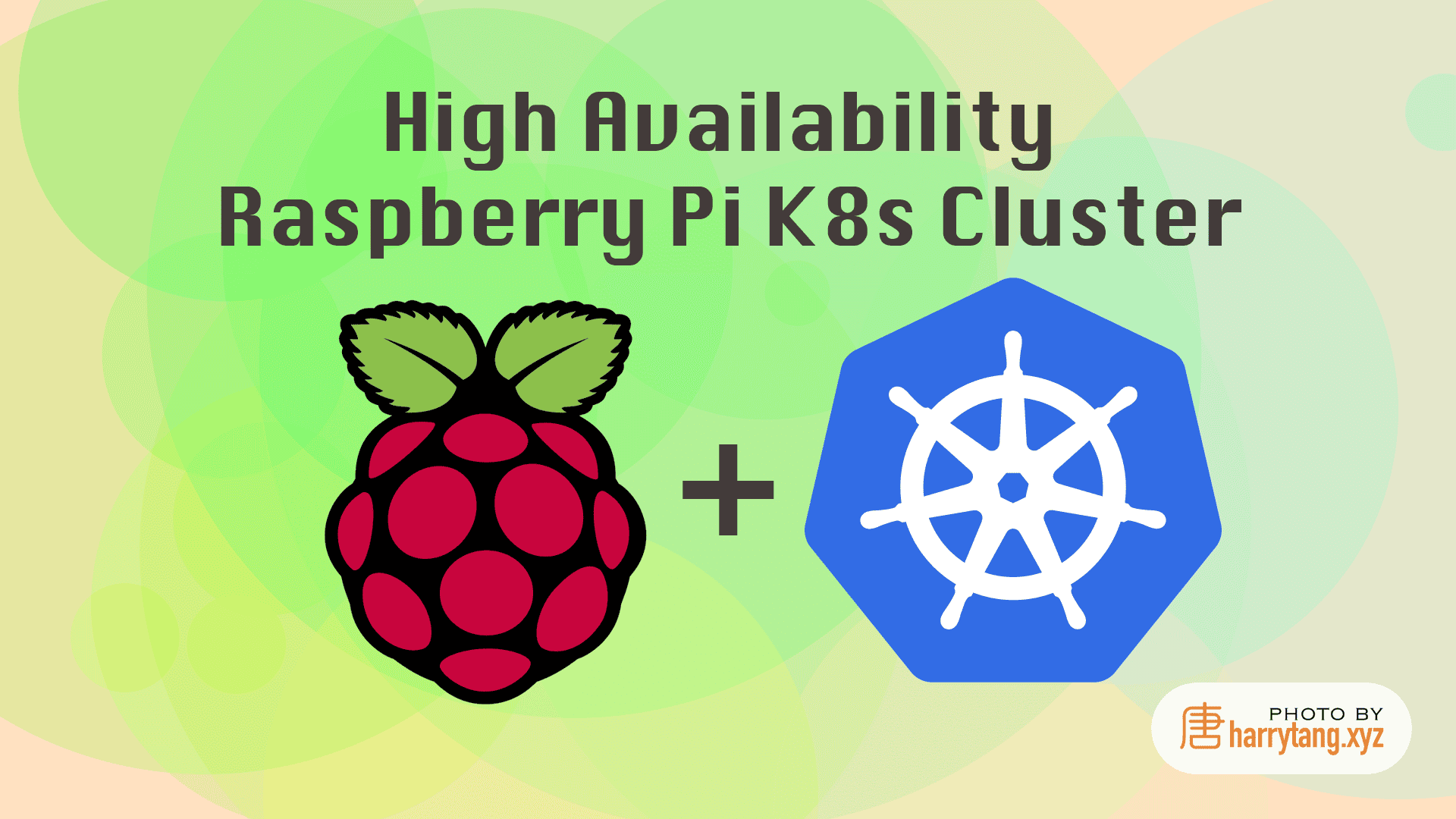High Availability Raspberry Pi K8s Cluster

Introduction
For tech enthusiasts, a home-lab setup can be incredibly useful. A great option to consider is deploying a Kubernetes (k8s) cluster on Raspberry Pi, which offers an affordable and efficient solution. Here is what I did to set up a HA K8s cluster for myself.
Prerequisites
- A domina name.
- Three or more Raspberry Pi devices.
- Ubuntu 24.04 OS flashed on each Pi.
- Private home network.
Step-by-step Guide
For this guide, I assume you have the domain harrytang.com and three Pi devices with the private IPs of 192.168.68.51, 192.168.68.52 and 192.168.68.53.
-
Config static IP addresses:
Edit the
/etc/netplan/50-cloud-init.yamlfile with the following settings:# /etc/netplan/50-cloud-init.yaml network: ethernets: eth0: dhcp4: no addresses: - 192.168.68.51/22 # 22 is the CIDR notation for 255.255.252.0 routes: - to: default via: 192.168.68.1 nameservers: addresses: - 1.1.1.1 - 1.0.0.1 - 2606:4700:4700::1111 - 2606:4700:4700::1001 optional: true version: 2Then, apply it and do the same for the other two devices:
sudo netplan try sudo netplan apply -
Install required packages (do this for all Pi devices):
sudo apt-get update && sudo apt-get upgrade -y sudo apt-get install -y net-tools iputils-ping ufw vim socat nfs-common cryptsetup -
Enable kernel modules and IP forwarding (do this for all Pi devices):
cat <<EOF | sudo tee /etc/modules-load.d/k8s.conf br_netfilter overlay dm_crypt EOF sudo modprobe br_netfilter sudo modprobe overlay sudo modprobe dm_crypt cat <<EOF | sudo tee /etc/sysctl.d/k8s.conf net.ipv4.ip_forward=1 net.ipv6.conf.all.forwarding=1 EOF sudo sysctl --system -
Configure the firewall (do this for all Pi devices):
sudo ufw allow ssh sudo ufw default allow routed # Allow routed traffic sudo ufw allow from 192.168.0.0/16 # Allow traffic from private network sudo ufw allow from fe80::/10 # Allow traffic from private network sudo ufw allow proto tcp from any to any port 80,443 # http, https sudo ufw enable sudo ufw status verbose -
Install Kubernetes components and CRI-O (do this for all Pi devices):
kubernetes_version=v1.31 crio_version="$kubernetes_version" # Add Kubernetes and CRI-O apt repositories curl -fsSL "https://pkgs.k8s.io/core:/stable:/$kubernetes_version/deb/Release.key" \ | sudo gpg --dearmor -o /etc/apt/keyrings/kubernetes-apt-keyring.gpg echo "deb [signed-by=/etc/apt/keyrings/kubernetes-apt-keyring.gpg] https://pkgs.k8s.io/core:/stable:/$kubernetes_version/deb/ /" \ | sudo tee /etc/apt/sources.list.d/kubernetes.list curl -fsSL "https://pkgs.k8s.io/addons:/cri-o:/stable:/$crio_version/deb/Release.key" \ | sudo gpg --dearmor -o /etc/apt/keyrings/cri-o-apt-keyring.gpg echo "deb [signed-by=/etc/apt/keyrings/cri-o-apt-keyring.gpg] https://pkgs.k8s.io/addons:/cri-o:/stable:/$crio_version/deb/ /" \ | sudo tee /etc/apt/sources.list.d/cri-o.list # Install Kubernetes and CRI-O packages sudo apt-get update k8s_version=$(apt-cache madison kubeadm | awk '{print $3}' | head -1) crio_version=$(apt-cache madison cri-o | awk '{print $3}' | head -1) sudo apt-get install -y kubeadm="$k8s_version" kubelet="$k8s_version" kubectl="$k8s_version" cri-o="$crio_version" sudo apt-mark hold kubeadm kubelet kubectl cri-o sudo systemctl enable --now crio -
Generate the Encryption Configuration file for encryption at rest:
Add more secure to your K8s cluster by using encryption at rest, follow this guide to generate the
/etc/kubernetes/enc/enc.yamlfile. -
Configure domain for K8s API endpoint:
Go to your domain panel and add a A Record of
k8s.harrytang.compoint to the first Pi device, e.g192.168.68.51:k8s.harrytang.com. 300 IN A 192.168.68.51 -
From the first Pi, initializes a Kubernetes control-plane node:
Create the init-config.yaml file:
apiVersion: kubeadm.k8s.io/v1beta3 kind: ClusterConfiguration controlPlaneEndpoint: 'k8s.harrytang.com:6443' etcd: local: extraArgs: listen-metrics-urls: http://0.0.0.0:2381 controllerManager: extraArgs: bind-address: '0.0.0.0' scheduler: extraArgs: bind-address: '0.0.0.0' networking: podSubnet: 10.1.0.0/16,fd01::/64 serviceSubnet: 10.96.0.0/16,fd98::/108 apiServer: extraArgs: - name: encryption-provider-config value: /etc/kubernetes/enc/enc.yaml certSANs: - 'k8s.harrytang.com' extraVolumes: - name: enc hostPath: /etc/kubernetes/enc mountPath: /etc/kubernetes/enc pathType: DirectoryOrCreate readOnly: true --- apiVersion: kubeadm.k8s.io/v1beta3 kind: InitConfiguration localAPIEndpoint: advertiseAddress: 192.168.68.51 bindPort: 6443 nodeRegistration: kubeletExtraArgs: node-ip: 192.168.68.51 --- apiVersion: kubelet.config.k8s.io/v1beta1 kind: KubeletConfiguration serverTLSBootstrap: true --- apiVersion: kubeproxy.config.k8s.io/v1alpha1 kind: KubeProxyConfiguration metricsBindAddress: '0.0.0.0:10249'Upgrade your configuration file to the latest version if required.
kubeadm config migrate --old-config init.yaml --new-config init-config.yamlThen, run:
sudo kubeadm config images pull sudo kubeadm init phase preflight sudo kubeadm init --config=init-config.yaml --upload-certsNext, deploy the Calico networking for the cluster:
kubectl create -f https://raw.githubusercontent.com/projectcalico/calico/v3.29.2/manifests/tigera-operator.yamlCreate the
calico.yaml:apiVersion: operator.tigera.io/v1 kind: Installation metadata: name: default spec: # Configures Calico networking. calicoNetwork: # Note: The ipPools section cannot be modified post-install. ipPools: - blockSize: 26 cidr: 10.1.0.0/16 encapsulation: VXLAN # Use this for Oracle Cloud Ubuntu 22.04 natOutgoing: Enabled nodeSelector: all() - blockSize: 122 cidr: fd01::/64 encapsulation: None natOutgoing: Enabled nodeSelector: all() --- # This section configures the Calico API server. # For more information, see: https://projectcalico.docs.tigera.io/master/reference/installation/api#operator.tigera.io/v1.APIServer apiVersion: operator.tigera.io/v1 kind: APIServer metadata: name: default spec: {}Then, apply it:
kubectl create -f calico.yamlFinally, reboot the Pi for Calio to configure the network properly:
sudo reboot ## Check if all good kubectl get pods -A NAMESPACE NAME READY STATUS RESTARTS AGE calico-system calico-kube-controllers-598654fc5f-2tj82 1/1 Running 2 4m39s calico-system calico-node-zmq2r 1/1 Running 1 4m39s calico-system calico-typha-7d99f69485-8qjr2 1/1 Running 1 4m40s calico-system csi-node-driver-xfngl 2/2 Running 2 4m39s kube-system coredns-7c65d6cfc9-756vf 1/1 Running 1 15m kube-system coredns-7c65d6cfc9-p8rc2 1/1 Running 1 15m kube-system etcd-pi1 1/1 Running 1 15m kube-system kube-apiserver-pi1 1/1 Running 1 15m kube-system kube-controller-manager-pi1 1/1 Running 1 15m kube-system kube-proxy-6dnbm 1/1 Running 1 15m kube-system kube-scheduler-pi1 1/1 Running 1 15m tigera-operator tigera-operator-89c775547-xbf9j 1/1 Running 1 5m45s -
Join the other two Pi devices as control-plane to form a High-availability cluster:
Create the
cp-config.yamlfile:apiVersion: kubeadm.k8s.io/v1beta4 kind: JoinConfiguration caCertPath: /etc/kubernetes/pki/ca.crt controlPlane: certificateKey: q1w2e3r4t5y6u7i8o9p0 # replace this localAPIEndpoint: advertiseAddress: 192.168.68.52 # 192.168.68.53 for the 3rd device bindPort: 6443 discovery: bootstrapToken: apiServerEndpoint: k8s.harrytang.com:6443 caCertHashes: - sha256:0p9o8i7u6y5t4r3e2w1q # replace this token: werwerw.qweertytyudfgsdf # replace this tlsBootstrapToken: werwerw.qweertytyudfgsdf # replace this nodeRegistration: kubeletExtraArgs: - name: node-ip value: 192.168.68.52 # 192.168.68.53 for the 3rd deviceAnd run the join command:
sudo kubeadm join --config=cp-config.yaml -
Update the K8s API endpoint with the remaining two IP addresses.
k8s.harrytang.com. 300 IN A 192.168.68.51 k8s.harrytang.com. 300 IN A 192.168.68.52 k8s.harrytang.com. 300 IN A 192.168.68.53 -
Verify and configure the control-plane nodes to treat them like worker nodes so they can start accepting pods:
kubectl get nodes NAME STATUS ROLES AGE VERSION pi1 Ready control-plane 4h21m v1.31.2 pi2 Ready control-plane 3h45m v1.31.2 pi3 Ready control-plane 3h51m v1.31.2 kubectl taint nodes --all node-role.kubernetes.io/control-plane-
Conclusion
Well done on setting up a Kubernetes (K8s) system for your home-lab! Now, you’re ready to install any applications you want on it.